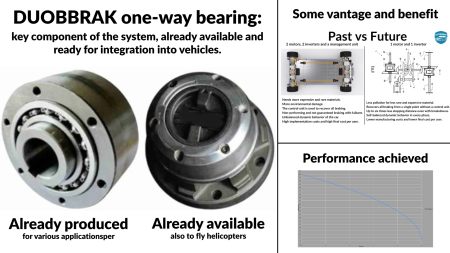Our members are dedicated to improving road safety and sharing their knowledge with the wider community. Here, you can explore our members' good practices – initiatives that have been assessed for their effectiveness in addressing a road safety problem and have proven results.
Get inspired – and sign up to share your good practices too!

Monday, April 14, 2025
We looked for solutions on how to improve the current situation regarding the availability of alcohol, its use and the prevention of drunk driving among young people in our and surrounding municipalities.

Thursday, April 10, 2025
Road safety in Europe and worldwide is still tragically compromised by a high number of accidents and avoidable loss of human lives.
This is compounded by the worrying frequency of vehicle recalls for brake problems, with over 3 million units affected in just two years (ANSA data), a symptom of an intrinsic vulnerability in current systems.
The dependence on rare materials in traditional braking systems and new technologies not only creates economic instability but also generates significant geopolitical implications.
Furthermore, there remains a lack of a reliable and universal mechanical solution capable of improving braking and ensuring safety in the event of failure.
These challenges highlight the urgent need for innovative solutions like DUOBBRAK, capable of overcoming the limitations of current systems, despite the resistance, and mostly the indifference, encountered in promoting it within the industry, accelerators, and public and private institutions
This is compounded by the worrying frequency of vehicle recalls for brake problems, with over 3 million units affected in just two years (ANSA data), a symptom of an intrinsic vulnerability in current systems.
The dependence on rare materials in traditional braking systems and new technologies not only creates economic instability but also generates significant geopolitical implications.
Furthermore, there remains a lack of a reliable and universal mechanical solution capable of improving braking and ensuring safety in the event of failure.
These challenges highlight the urgent need for innovative solutions like DUOBBRAK, capable of overcoming the limitations of current systems, despite the resistance, and mostly the indifference, encountered in promoting it within the industry, accelerators, and public and private institutions

Thursday, April 10, 2025
Guardrails installed on road bridges are essential to the safety of vehicles and road users. May accidents happen every year, involving vehicles falling from bridges with often fatal consequences. These issues have caused, in Italy, in the last decade, more fatalities than bridge collapses, even if we count the Morandi bridge collapse victims.
Many infrastructure managers, especially at the local level, often lack accurate and up-to-date inventories of the safety barriers on their bridges. Moreover, the limited availability of financial resources, combined with the lack of personnel, makes it difficult for these entities to effectively assess the condition of such critical infrastructure. This proposed technology is represented by an integrated methodology to automate the assessment of road guardrails installed on bridges using open-source data and deep learning (DL) algorithms. It innovatively uses YOLO (You Only Look Once) object detection algorithm to classify the safety barriers to establish whether they match the current standards. To speed up the evaluation process, the software tool involves the extraction of bridge information from OpenStreetMap (OSM) to construct a database of existing bridges, which most road management bodies miss. This is integrated with Google Street View API, for the extraction of images of each bridge’s safety barriers to be analysed by YOLO. The synergic concatenation of these three steps (OSM, Google Street View, YOLO) into a unique software tool, provides road managers with a cost-effective and efficient tool to remotely survey the guardrails installed on their bridges, permitting to timely identify bridges needing barrier replacment.
Many infrastructure managers, especially at the local level, often lack accurate and up-to-date inventories of the safety barriers on their bridges. Moreover, the limited availability of financial resources, combined with the lack of personnel, makes it difficult for these entities to effectively assess the condition of such critical infrastructure. This proposed technology is represented by an integrated methodology to automate the assessment of road guardrails installed on bridges using open-source data and deep learning (DL) algorithms. It innovatively uses YOLO (You Only Look Once) object detection algorithm to classify the safety barriers to establish whether they match the current standards. To speed up the evaluation process, the software tool involves the extraction of bridge information from OpenStreetMap (OSM) to construct a database of existing bridges, which most road management bodies miss. This is integrated with Google Street View API, for the extraction of images of each bridge’s safety barriers to be analysed by YOLO. The synergic concatenation of these three steps (OSM, Google Street View, YOLO) into a unique software tool, provides road managers with a cost-effective and efficient tool to remotely survey the guardrails installed on their bridges, permitting to timely identify bridges needing barrier replacment.

Wednesday, April 9, 2025
The C•AUTO project addresses several persistent and emerging road safety challenges, particularly within urban environments. One of the main problems we focus on is excessive vehicle speed in sensitive areas such as school zones, hospitals, pedestrian crossings, and high-risk intersections. Despite existing signage and infrastructure, speeding remains a leading cause of accidents, particularly those involving vulnerable road users like children, the elderly, and cyclists.
Another key issue is the lack of adaptive and proactive tools to manage traffic behavior in real-time. Current solutions often react after incidents occur, rather than preventing them. C•AUTO proposes an innovative approach through the deployment of intelligent electric vehicles that function as mobile “City Safety Cars.” These vehicles travel at regulated speeds and use predictive data to position themselves strategically in urban areas with higher accident risk.
Furthermore, C•AUTO tackles the challenge of building a shared safety culture. It aims to influence driver behavior through presence, not punishment—creating an environment of passive regulation, education, and visual deterrence rather than relying solely on fines or enforcement.
By addressing both infrastructural gaps and behavioral aspects, C•AUTO contributes to achieving the Vision Zero goal of eliminating fatalities and serious injuries on our roads.
Another key issue is the lack of adaptive and proactive tools to manage traffic behavior in real-time. Current solutions often react after incidents occur, rather than preventing them. C•AUTO proposes an innovative approach through the deployment of intelligent electric vehicles that function as mobile “City Safety Cars.” These vehicles travel at regulated speeds and use predictive data to position themselves strategically in urban areas with higher accident risk.
Furthermore, C•AUTO tackles the challenge of building a shared safety culture. It aims to influence driver behavior through presence, not punishment—creating an environment of passive regulation, education, and visual deterrence rather than relying solely on fines or enforcement.
By addressing both infrastructural gaps and behavioral aspects, C•AUTO contributes to achieving the Vision Zero goal of eliminating fatalities and serious injuries on our roads.

Friday, April 4, 2025
Valerann is tackling critical road safety challenges associated with complexity and criticality of road traffic management and road safety.
Traditional road monitoring systems often rely heavily on fixed infrastructure, which can be limited in coverage and responsiveness. The increase of data sources (CAV, crowdsourced data, navigation apps etc) brings an opportunity to enrich situational awareness of TMCs; but it also brings a challenge of data fragmentation, data overload and confusion as deliver high volumes of unstructured data and false positives, overwhelming operators and delaying meaningful action. In response, Valerann deployed Lanternn by Valerann™, an AI-powered data fusion platform that transforms how traffic data is collected, processed, and acted upon. The key safety challenge being addressed is the speed and accuracy of incident detection. Delays in identifying road incidents can increase the risk of secondary collisions, congestion, and response inefficiency. LbV synthesises diverse data sources—floating car data, roadside sensors, navigation apps, weather feeds, and even social media—into a single coherent operational picture. This fusion allows for earlier detection of accidents, faster validation, and more efficient emergency response. The system not only enhances situational awareness but also supports smarter infrastructure planning by highlighting patterns and bottlenecks. Ultimately, Valerann is modernising traffic management for safer, more resilient roads without the need for costly physical infrastructure expansion.
Traditional road monitoring systems often rely heavily on fixed infrastructure, which can be limited in coverage and responsiveness. The increase of data sources (CAV, crowdsourced data, navigation apps etc) brings an opportunity to enrich situational awareness of TMCs; but it also brings a challenge of data fragmentation, data overload and confusion as deliver high volumes of unstructured data and false positives, overwhelming operators and delaying meaningful action. In response, Valerann deployed Lanternn by Valerann™, an AI-powered data fusion platform that transforms how traffic data is collected, processed, and acted upon. The key safety challenge being addressed is the speed and accuracy of incident detection. Delays in identifying road incidents can increase the risk of secondary collisions, congestion, and response inefficiency. LbV synthesises diverse data sources—floating car data, roadside sensors, navigation apps, weather feeds, and even social media—into a single coherent operational picture. This fusion allows for earlier detection of accidents, faster validation, and more efficient emergency response. The system not only enhances situational awareness but also supports smarter infrastructure planning by highlighting patterns and bottlenecks. Ultimately, Valerann is modernising traffic management for safer, more resilient roads without the need for costly physical infrastructure expansion.